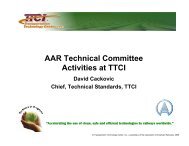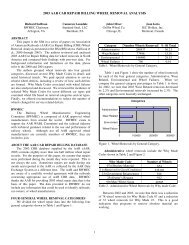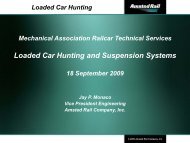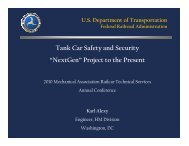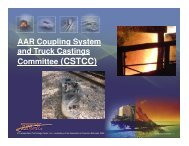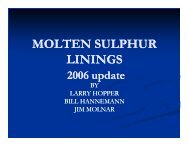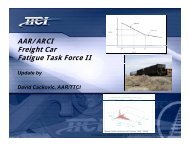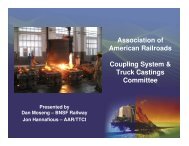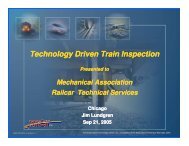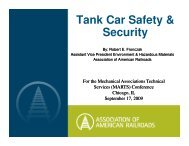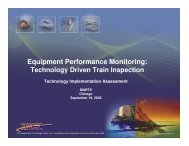EFFECTS OF WHEEL/RAIL CONTACT PATTERNS ... - Marts-rail.org
EFFECTS OF WHEEL/RAIL CONTACT PATTERNS ... - Marts-rail.org
EFFECTS OF WHEEL/RAIL CONTACT PATTERNS ... - Marts-rail.org
You also want an ePaper? Increase the reach of your titles
YUMPU automatically turns print PDFs into web optimized ePapers that Google loves.
®<br />
<strong>EFFECTS</strong> <strong>OF</strong> <strong>WHEEL</strong>/<strong>RAIL</strong><br />
<strong>CONTACT</strong> <strong>PATTERNS</strong> and<br />
VEHICLE PARAMETERS on<br />
LOADED CAR HUNTING<br />
Nicholas Wilson, Huimin Wu, Harry Tournay, Curtis Urban<br />
Transportation Technology Center, Inc<br />
Pueblo, CO, USA<br />
MARTS Chicago September 2009 - 1<br />
© Transportation Technology Center, Inc., a subsidiary of the Association of American Railroads, 2009
Background<br />
In 2006, failures of primary<br />
suspension adapter pads<br />
were reported on a particular<br />
type of grain car:<br />
• Loaded high capacity (286k<br />
lbs) grain hoppers<br />
• Truck hunting: loaded<br />
hunting is unusual<br />
• M-976 trucks with improved<br />
tracking<br />
• Routes with specific <strong>rail</strong><br />
wear patterns and tighter<br />
gage<br />
®<br />
© TTCI/AAR, 2009, MARTS Chicago, September 2009 p2
Primary Suspension Adapter Pads<br />
Polymer pads improve axle<br />
steering, reduce W/R forces<br />
and rolling resistance<br />
Loaded Hunting motions<br />
appeared to cause failures:<br />
• Pi Primary suspension pads<br />
If a pad does fail, it is<br />
typically only 1 out of 8<br />
in a car<br />
• Constant<br />
contact side<br />
bearings<br />
(CCSB)<br />
®<br />
© TTCI/AAR, 2009, MARTS Chicago, September 2009 p3
Initial Lateral Stability (Hunting)Tests<br />
50 mph Tests performed at TTC<br />
®<br />
© TTCI/AAR, 2009, MARTS Chicago, September 2009 p4
Initial Lateral Stability (Hunting)Tests<br />
Tests performed at TTC<br />
Wheel<br />
Loaded Hunting Threshold Speed<br />
Profile Empty ~ Summer Winter<br />
Standard<br />
and<br />
Conicity<br />
Standard Pads Standard<br />
Pads<br />
Standard<br />
Pads<br />
Stiffer Pads Steel<br />
Adapters<br />
Worn<br />
λ>0.6<br />
KR<br />
λ>0.2<br />
AAR1B<br />
λ>0.05 005<br />
65 mph 47.5 mph 55.5 mph 65 mph 70 mph<br />
80 mph 65 mph 75 mph 80 mph<br />
>80 mph 75 mph 80 mph 80 mph<br />
®<br />
© TTCI/AAR, 2009, MARTS Chicago, September 2009 p5
Initial Hunting Test Conclusions<br />
Loaded car hunting a function of<br />
• Car body mass and inertial properties<br />
• High W/R Conicity<br />
Worn wheels<br />
Worn <strong>rail</strong> profile in straight track<br />
• Adapter pad stiffness<br />
Loaded car hunting also a function of:<br />
• Center plate friction<br />
Steel center plates reduced hunting<br />
• Side bearing friction restraint<br />
®<br />
© TTCI/AAR, 2009, MARTS Chicago, September 2009 p6
Grain Car Wheel Wear and Effects on Conicity<br />
Higher wear in this<br />
tread region<br />
160,000 mile<br />
New AAR-1B<br />
96,000 miles<br />
35,000 miles<br />
Relatively low<br />
wear in this<br />
region<br />
Conicity (λ)<br />
on TTCI<br />
Hunting<br />
test t zone<br />
Con nicity<br />
®<br />
© TTCI/AAR, 2009, MARTS Chicago, September 2009 p7<br />
0.7<br />
0.6<br />
0.5<br />
0.4<br />
0.3<br />
0.2<br />
0.1<br />
0<br />
New AAR-1B<br />
Average Conicity, RTT 34 Rail<br />
96,000 miles<br />
35,000 miles<br />
160,000 miles<br />
Avg<br />
Max<br />
Min<br />
0 40 80 120 160 200<br />
Mileage (*1000)
High Conicity W/R Contact Conditions<br />
Increased conicity on tangent track after ~ 160,000 km<br />
Tangent <strong>rail</strong> head profiles:<br />
• Certain new <strong>rail</strong><br />
sections<br />
• Tight gauge<br />
New Rail<br />
• “Flattened” crowns<br />
&<br />
• Flow to the gauge<br />
corner<br />
Flat <strong>rail</strong>head &<br />
plastic flow<br />
®<br />
© TTCI/AAR, 2009, MARTS Chicago, September 2009 p8
Wheel / Rail Profiles<br />
Accelerated initial flange wear<br />
Average Wheel Flange Width<br />
Flan nge Width (mm m)<br />
36<br />
35<br />
34<br />
33<br />
0 50 100 150 200 250<br />
Mileage (*1000)<br />
Associated with<br />
initial mismatch &<br />
2-point contact<br />
between new<br />
wheel & worn<br />
high <strong>rail</strong> in curves<br />
New AAR1-B Wheel<br />
1mm gap<br />
≅12 mm RRD<br />
Worn <strong>rail</strong>s from 2 degree, 4, degree,<br />
and 6 degree curves<br />
®<br />
© TTCI/AAR, 2009, MARTS Chicago, September 2009 p9
Wheel / Rail Profiles<br />
Reduced flange wear after ~ 50,000 miles<br />
Average Wheel Flange Width<br />
Flange eWidth (mm)<br />
36<br />
35<br />
34<br />
33<br />
0 50 100 150 200 250<br />
Mileage (*1000)<br />
Associated with single<br />
point contact & a large<br />
radius differential<br />
generated on the high<br />
<strong>rail</strong> in curves<br />
®<br />
© TTCI/AAR, 2009, MARTS Chicago, September 2009 p10
W/R Conicity as a Function of Mileage, Car and<br />
Truck Arrangement<br />
Car/Truck types<br />
• Gen I: Grain car with<br />
steel adapters<br />
• Gen II: Grain car with<br />
polymer adapters<br />
• Coal: Coal car with steel<br />
adaptors<br />
• Coal HD: Coal car with<br />
polymer adapters<br />
Root causes for<br />
differences are still<br />
unknown but<br />
suspected to be a<br />
function of:<br />
• Curving ability<br />
• Vehicle stability<br />
®<br />
© TTCI/AAR, 2009, MARTS Chicago, September 2009 p11
W/R Conicity as a Function of Rail Profiles for a<br />
Particular Grain Car Route<br />
• Analysis of conicity for 108 axles on 25,000 measured<br />
<strong>rail</strong> profiles from 19 miles of tangent track<br />
Percenta<br />
age of Mea<br />
asured Rails<br />
Conicity ≅ 01<br />
0.1<br />
Rails producing lower<br />
conicity<br />
Conicity ≅ 0.4<br />
Rails producing higher<br />
conicity<br />
Mainly due<br />
to worn wheels<br />
Percentage of Exception (Wheels)<br />
®<br />
© TTCI/AAR, 2009, MARTS Chicago, September 2009 p12
Tangent Track W/R Conicity Summary<br />
New AAR-1b wheels<br />
produce low conicity on all<br />
<strong>rail</strong> profiles<br />
Rails with a low <strong>rail</strong> shoulder<br />
produce lower conicities,<br />
high shoulder gives high<br />
conicity<br />
Conformal contact tends to<br />
produce low conicity λ = 0.05<br />
Rail profile<br />
pair from the<br />
high conicity<br />
group<br />
Rail profile pair<br />
from the high<br />
conicity group<br />
Rail profile pair<br />
from the low<br />
conicity ii group<br />
Rail profile pair<br />
from the low<br />
conicity group<br />
Flattened <strong>rail</strong>s, gauge flow<br />
and narrow gauge produce<br />
high conicities<br />
λ >035<br />
0.35<br />
®<br />
© TTCI/AAR, 2009, MARTS Chicago, September 2009 p13
Tangent Track W/R Conicity Summary (cont.)<br />
Tight gauge is highly correlated to high conicity in<br />
tangent track<br />
Exce eedance of Wheels<br />
(%)<br />
57<br />
90<br />
56.9<br />
Conicity Exceedance Wheelset % Gage Spacing inches<br />
56.8<br />
56.7<br />
60<br />
56.6<br />
56.5<br />
56.4<br />
30<br />
56.3<br />
56.2<br />
56.1<br />
0<br />
56<br />
12200 12220 12240 12260 12280 12300 12320 12340 12360 12380 12400<br />
Distance (feet)<br />
High conicity was found on only 10% of track<br />
Rail grinding to relieve reduce flattened <strong>rail</strong>s, relieve<br />
the gauge corner and remove metal flow in the<br />
gauge corner could reduce conicity<br />
A more conformal new wheel profile could change<br />
the rapid initial wear pattern of new wheels<br />
®<br />
© TTCI/AAR, 2009, MARTS Chicago, September 2009 p14<br />
Gage (in)
Truck Hunting and Warp Dynamics<br />
Loaded hunting tests<br />
revealed:<br />
• Predominantly in-phase<br />
motion (warp) of the<br />
wheelsets & truck<br />
bolster<br />
• Little longitudinal<br />
deflection of the<br />
adapter pads<br />
• Dependence on<br />
moments due to the<br />
adapters / adapter pads<br />
& truck rotation on<br />
stability<br />
®<br />
© TTCI/AAR, 2009, MARTS Chicago, September 2009 p15
Truck Warp Test Results<br />
Avg. stiffness = 140 klb-in/mrad<br />
Avg. stiffness = 12.5 klb-inmrad<br />
High warp restraint<br />
similar to previous tests<br />
of the same truck type<br />
when friction wedges<br />
have little motion<br />
®<br />
© TTCI/AAR, 2009, MARTS Chicago, September 2009 p16<br />
Warp stiffness reduced<br />
by factor of about 11 due<br />
to friction saturation<br />
with large wedge motions<br />
from combined body<br />
vertical/lateral motions
NUCARS ® simulations to evaluate W/R forces and<br />
effects of Carbody and Suspension Parameters<br />
40,000000 lbs<br />
net lateral<br />
axle force<br />
®<br />
© TTCI/AAR, 2009, MARTS Chicago, September 2009 p17
W/R Forces due to Loaded Hunting<br />
NUCARS ® simulations of loaded grain car hunting<br />
show potential for very high W/R forces<br />
Large Net<br />
Axle L/V<br />
ratios could<br />
cause track<br />
panel shift<br />
Large<br />
truckside L/V<br />
could cause<br />
gauge<br />
widening and<br />
<strong>rail</strong> rollover<br />
®<br />
© TTCI/AAR, 2009, MARTS Chicago, September 2009 p18
Progression to Loaded Car Hunting<br />
Accelerated wheel wear occurs in curves as a result of<br />
a “mismatch” between the high <strong>rail</strong> profile & that on<br />
tangent track<br />
• 2-point contact<br />
• High <strong>rail</strong> “conditions” the wheel of a car making flange<br />
contact to a conformal profile<br />
“Conditioning” results in high conicity, especially on<br />
particular sections of tangent track<br />
• New <strong>rail</strong> of particular section<br />
• “Flattened” <strong>rail</strong> with material flow to the gauge corner<br />
• Sections of track with tight gauge<br />
®<br />
© TTCI/AAR, 2009, MARTS Chicago, September 2009 p19
Progression to Loaded Car Hunting (cont.)<br />
High conicity on tangent track<br />
• On sections where higher speeds occur<br />
• High creep forces under load excite the wheelsets<br />
to yaw/warp the truck frame<br />
to yaw within the truck frame on soft adapter pads<br />
Wheelset & truck yaw excite particular (longer) car<br />
bodies in a yaw-dominated mode (includes roll)<br />
Car body yaw and coupled roll motions saturate the<br />
truck wedge system, reducing the warp restraint<br />
Reduced warp restraint results in resonance between<br />
wheelset, truck & car body yaw above certain threshold<br />
speeds<br />
®<br />
© TTCI/AAR, 2009, MARTS Chicago, September 2009 p20
Progression to Loaded car Hunting (cont.)<br />
Truck warp restraint breaks-down almost completely<br />
Wheelset hollowing (& conicity) increases as a<br />
consequence of the hunting motion<br />
Loaded car hunting occurs:<br />
• At progressively lower speeds<br />
• On increasingly longer sections of tangent track<br />
Pad failure results together with degradation of<br />
constant contact side bearing elements<br />
®<br />
© TTCI/AAR, 2009, MARTS Chicago, September 2009 p21
Loaded Car Hunting: Conclusions<br />
Loaded car hunting is a system problem:<br />
• Only certain car types – many cars with trucks do<br />
not hunt<br />
• Depends on truck center spacing, car body inertial<br />
characteristics (centers of gravity & moments of<br />
inertia associated with high capacity cars for low<br />
density bulk products)<br />
• Wheelset and truck constraints (adapter pad<br />
stiffnesses, loss of warp restraint due to friction<br />
wedge motion)<br />
• Track (<strong>rail</strong> profile mismatch, <strong>rail</strong> deformation, tight<br />
gauge)<br />
g ®<br />
© TTCI/AAR, 2009, MARTS Chicago, September 2009 p22
Loaded Car Hunting: Conclusions (cont.)<br />
Many types of car with these trucks do not<br />
experience loaded car hunting:<br />
• Need “tune” the car and truck suspension parameters<br />
to the specific car body characteristics:<br />
Truck spacing, inertial parameters (CG height, yaw<br />
and roll moments of inertia)<br />
Wheelset and truck constraints (adapter pad<br />
stiffnesses, truck warp restraint)<br />
Loaded hunting may lead to very high W/R forces<br />
• Possibility for increased risk of track damage and<br />
de<strong>rail</strong>ment (Oct 2009 tests will measure forces w/IWS)<br />
®<br />
© TTCI/AAR, 2009, MARTS Chicago, September 2009 p23
Way Forward: Standards and Testing<br />
Primary Suspension Pad Durability Standards<br />
• AAR MSRP, Volume H, Section 4.3.2<br />
Develop M-976 and Chapter 11 Loaded Hunting<br />
Test/Analysis Requirements (2009)<br />
• What wheel profile<br />
• What car body and inertial parameters (M-976)<br />
• What performance criteria<br />
Loaded Hunting Tests at TTCI (Oct/Nov 2009)<br />
• Support development of loaded hunting tests<br />
• IWS to measure W/R forces while hunting<br />
®<br />
© TTCI/AAR, 2009, MARTS Chicago, September 2009 p24
Way Forward: Wheel and Rail Profiles<br />
Rail grinding to relieve reduce flattened <strong>rail</strong>s,<br />
relieve the gauge corner and remove metal flow in<br />
the gauge corner could reduce conicity<br />
A more conformal new wheel profile could change<br />
the rapid initial iti wear pattern of new wheels<br />
• A new wheel profile design for freight cars is being<br />
evaluated at TTCI to replace the AAR-1b<br />
• Based on worn wheel shapes<br />
• More conformal to existing <strong>rail</strong> profiles in curves and<br />
straight track<br />
• Narrower flange for more gage clearance<br />
®<br />
© TTCI/AAR, 2009, MARTS Chicago, September 2009 p25
Immediate:<br />
Way Forward: Car and Truck Design<br />
• Replace adapters & pads with standard adapters<br />
• Consequent reduction in curving performance<br />
(increased wheel wear & wheel RCF)<br />
Intermediate:<br />
• Stiffer pads<br />
• Partial improvement in tracking performance (reduced<br />
wheel wear & wheel RCF)<br />
Long term:<br />
• Improved freight truck with reduced stiffness pads &<br />
increased warp restraint<br />
• Reduced wheel wear & eliminated RCF<br />
®<br />
© TTCI/AAR, 2009, MARTS Chicago, September 2009 p26
Thank you for your attention!<br />
Nicholas Wilson<br />
Transportation Technology Center Inc.<br />
Pueblo<br />
Colorado<br />
USA<br />
MARTS Chicago September 2009 - 27<br />
© Transportation Technology Center, Inc., a subsidiary of the Association of American Railroads, 2009




